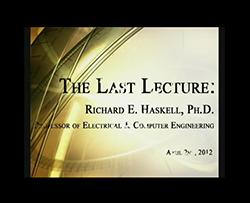Last Lecture
I retired from Oakland University in 2012, and on April 2, 2012 gave a Last Lecture at Meadow Brook Theatre. You can view this Last Lecture by clicking on the following figure. It lasts about 55 minutes.
Since retiring, I have written the eight books shown on this page. Peggy's Discovery is a novel based on many of the ideas I discussed in my Last Lecture. In the novel, Peggy discovers a Theory of Everything. The technical details of everything in the novel are spelled out in the book, Understanding Special Relativity and Maxwell's Equations - With Implications for a Unified Field Theory. I think you will find the Preface to this book interesting. You can read it here. All of the mathematics that you need to understand this book can be found in the book, Vectors and Tensors By Example - Including Cartesian Tensors, Quaternions, and Matlab Examples. The book, Ideas that made your Smartphone - Why the patent system should be abolished, describes many of the thousands of ideas that went into making your smartphone and makes the case that the patent system should be abolished. Fourier Analysis By Example - Including Matlab Examples is my unique approach to understanding Fourier analysis. Magical Journey is a historical novel of the year 1952, seen through the eyes of thirteen-year-old Ricky, who travels with his family through all forty-eight states, giving magic shows and meeting people who make America magical. Discovering Mathematics with Excel is a new approach to covering first-year college mathematics. Discovering Mathematics with MATLAB continues this approach for higher-level college mathematics. Click on any of the book covers to order the book from Amazon.

Magical Journey
Magical Journey is the story of Ricky, a thirteen-year-old minister’s son, who is forced to move from his comfortable home in Maine when his father is called to a new church in New Hampshire. His dad, who is also a professional magician, takes the family on a seven-month cross-country journey in a converted school bus to all forty-eight states in 1952 America. Ricky is unhappy about moving until his next-door neighbor, the local newspaper editor, offers him an opportunity that allows him to grow in unexpected ways and learn what makes America magical.
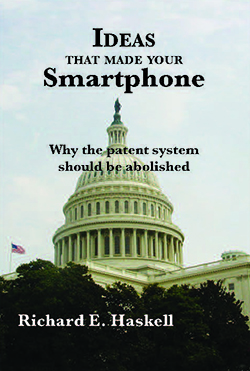
Ideas that made your Smartphone
Thousands of ideas, going back 200 years, went into making your smartphone. What were some of the most important of these ideas, and who came up with them? In this book, you will meet some of these inventors and learn about their interactions with the patent system. You will see that in many cases the patent system fails to live up to its intended purpose, which is “to promote the progress of science and the useful arts.” You will see that by its very nature, it does just the opposite. You will see that countless hours and dollars are wasted in the litigation of patent claims, that patents are not always awarded to the true inventor, that judges and juries are not competent to judge the validity of patents, that inventions are always based on the work of others, and that patents stifle economic growth. You will see that the very idea of regarding intellectual ideas as property is misplaced, leading one to question the very existence of the patent system.
Table of Contents
Chapter 1

Peggy's Discovery
A book containing a short, simple equation that explains all of physical reality is ignored when published, disappearing from public view for fifty years, until a high-school senior, with the encouragement of her engineering professor uncle, enters college on a quest to understand the nature of physical reality by challenging conventional wisdom. In the process, she starts a company that revolutionizes higher education, leading her to uncover the secret to a theory of everything.
About the author:
Richard E. Haskell grew up in New Hampshire and is Emeritus Professor of Engineering at Oakland University in Rochester, Michigan, where he taught electrical and computer engineering for 46 years. He is the author of over thirty books ranging from plasma dynamics to digital design. He currently lives in New Hampshire.
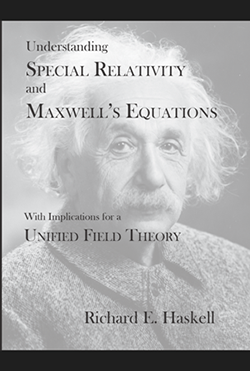
Understanding Special Relativity and Maxwell's Equations - With Implications for a Unified Field Theory
Book Highlights:
- Graphical approach to special relativity
- Quaternion representation of the Lorentz transformation
- Relativistic dynamics
- Derivation of Maxwell’s equations from Coulomb’s law and special relativity
- A different approach to gravitational fields
- Details of a little-known unified field theory
Preface
Table of Contents
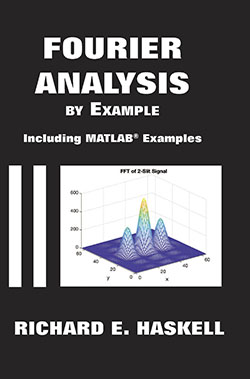
Fourier Analysis By Example
This book begins with examples of calculating the Fourier Transform of various functions and shows that calculating the Fourier Transform of a periodic function leads to the Fourier Series, calculating the Fourier Transform of a sampled function leads to the Discrete-Time Fourier Transform (DTFT), and calculating the Fourier Transform of a sampled, periodic function leads to the Discrete Fourier Transform (DFT). The book includes a detailed derivation of the Fast Fourier Transform (FFT) algorithm for computing the Discrete Fourier Transform. Numerous MATLAB examples of using the FFT include examples of amplitude and frequency modulation as well as binary and quadrature phase shift keying of digital signals. The book shows how the Discrete Cosine Transform (DCT) can be derived from the FFT, and the example of using the two-dimensional DCT as part of the JPEG image compression algorithm is described. Examples from Fourier optics are also included in the book.
Preface
Table of Contents
Chapter 1
All MATLAB Examples (zip file)

Dixcovering Mathematics with Excel
This book presents a new approach to learning first-year college mathematics by using an Excel spreadsheet to discover the fundamentals of a wide range of mathematical topics, including geometry, calculus, number theory, trigonometry, probability and statistics, algebra, vectors, and differential equations. Unique topics covered include fractal geometry and chaos.
Table of Contents

Dixcovering Mathematics with MATLAB
This book offers a new approach to learning college mathematics. It continues the discovery process that began in Discovering Mathematics with Excel, which covered first-year college mathematics. This book expands those topics to higher-dimensional variables. Topics include partial derivatives, multiple integrals, matrices, solving linear equations, eigenvalues and eigenvectors, solving systems of ordinary differential equations, vector fields, Maxwell’s equations, solving partial differential equations using MATLAB, Fourier transforms, and more..
Table of Contents
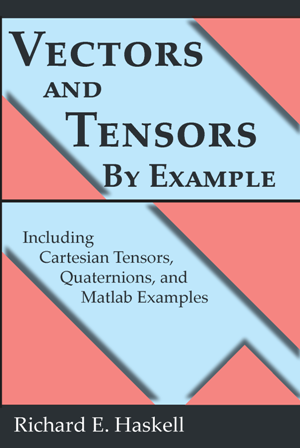
Vectors and Tensors By Example - Including Cartesian Tensors, Quaternions, and Matlab Examples
If you have been confused by vectors, vector calculus, tensor analysis, or quaternions, this book is for you. Packed with examples, including Matlab examples, this book will show you
- How to use Matlab to calculate dot and cross products, and solve linear equations;
- How to prove any vector identity using Cartesian tensors;
- How to derive the expressions for gradient, divergence, Laplacian, and curl in any curvilinear coordinate system;
- How to understand covariant and contravariant components of a vector;
- The meaning of Christoffel symbols in covariant differentiation;
- How to derive the curvature tensor;
- How quaternions can be used to describe vector rotations in 3-D space.

